Coronavirus Today: What’s going on in China?
- Share via
Good evening. I’m Karen Kaplan, and it’s Tuesday, Jan. 10. Happy New Year! Here’s the latest on what’s happening with the coronavirus in California and beyond.
As expected — and feared — the big story when it comes to COVID-19 is China. Since the government there eased up on its onerous “zero COVID” restrictions last month, the coronavirus has indeed taken advantage of its opportunity to spread through a population of 1.4 billion people that is under-vaccinated and has little to no prior exposure to the virus.
It’s unclear just how bad things are, because the government hasn’t provided updates on new cases and deaths since Dec. 24.
“Right now the pandemic situation in China is not transparent,” said Wang Pi-sheng, the head of Taiwan’s epidemic command center. “We have a very limited grasp on its information, and it’s not very accurate.”
Even the head of the World Health Organization lamented the tight lips in Beijing. In addition to wanting details on infections and deaths, WHO would like to have a better handle on hospitalizations, vaccinations and any new variants that may be brewing.
“Data remains essential for WHO to carry out regular, rapid and robust risk assessments of the global situation,” Director-General Tedros Adhanom Ghebreyesus said last week.
The news that is getting through isn’t exactly encouraging: Workers across the country are too sick to show up for their shifts. Fever-reducing medicines are in short supply. Crematoria staff are putting in a lot of overtime. Government officials are asking residents to think twice before traveling home for the upcoming Lunar New Year holiday.
About two weeks after the easing of zero COVID rules, hospitals in Hebei province had run out of beds in their intensive care units. Patients were forced to lie on the floor and incoming ambulances were turned away.
Last week, hospitals in Beijing were overwhelmed with elderly patients who waited on stretchers or in wheelchairs for rooms to open up. Some were being hooked up to IVs and oxygen tanks in the hallways.
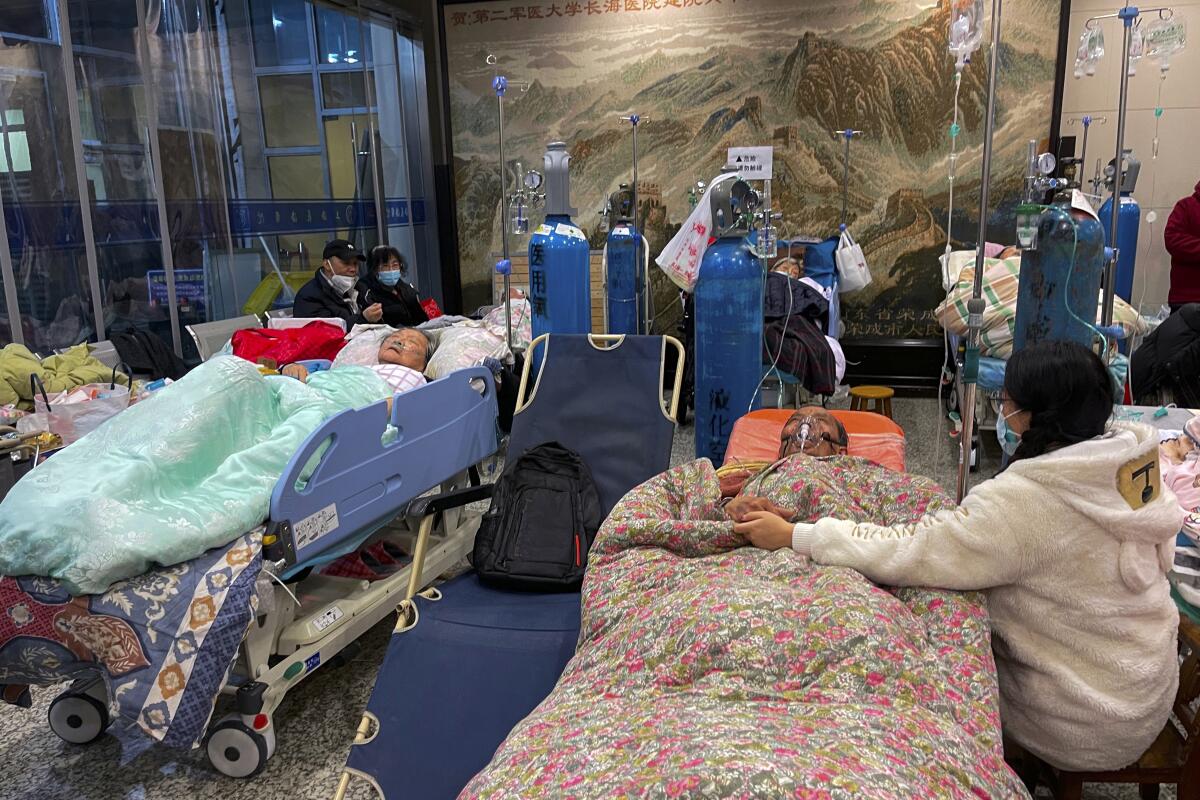
Elderly people are particularly vulnerable not just because of their age, but because they are less likely to be vaccinated against COVID-19. Chinese officials originally focused on immunizing younger people because they’re more mobile and could have helped the virus move around the country. The government switched its focus to residents older than 60 in late November, but it’s hard to say whether their campaign is working.
Not surprisingly, the virus has spread fastest in the country’s densely populated cities. It may slow as it reaches smaller towns and rural areas, but those places also have weaker healthcare systems.
Forecasters outside China have predicted the country could experience around 1 million COVID-19 deaths or more in 2023. A study by Hong Kong University said the death toll would be nearly 1 million if the government can’t provide enough booster shots and antiviral treatments. Modelers at the Institute for Health Metrics and Evaluation at the University of Washington say China would hit the 1-million mark if the virus is allowed to spread unchecked, but added that the government would probably reinstate some pandemic control measures to prevent that from happening.
Airfinity, a health analytics firm based in London, has a more pessimistic outlook: 1.7 million deaths by May 1. It estimates the current wave of infections will peak on Friday, with 3.7 million new cases that day, followed by a quicker, second wave that will peak on March 3, with 4.2 million new cases.
Amid all this uncertainty, the United States and other countries have opted to play it safe by asking travelers from China to produce a negative coronavirus test before boarding their planes. In some places, they’ll also be subject to random testing upon arrival.
Chinese officials aren’t happy with those rules, to say the least. “We are firmly opposed to attempts to manipulate the COVID measures for political purposes and will take countermeasures based on the principle of reciprocity,” a Foreign Ministry spokesperson said. In what is being viewed as a retaliatory move, Chinese embassies in Tokyo and Seoul stopped issuing new visas for people from Japan and South Korea on Tuesday.
Keeping infected people away isn’t the only reason for the testing. A program run by the Centers for Disease Control and Prevention asks visitors to swab their noses to help them spot any new coronavirus variants that might jump-start a new wave of illness. The year-old Traveler Genomic Surveillance program set up shop at Los Angeles International Airport last week specifically to monitor viral specimens from China.
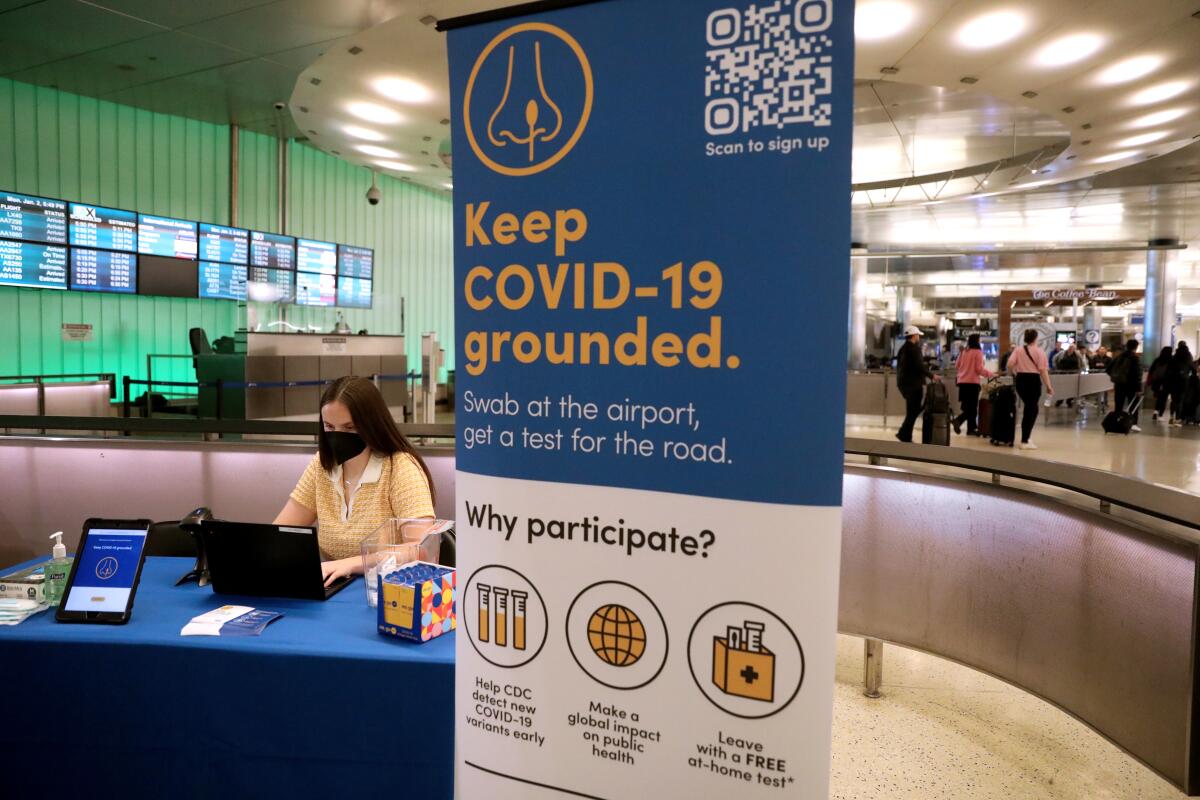
“New variants can arise anywhere there’s uncontrolled infection, and COVID is spreading through China like wildfire,” Harvard University infectious-disease specialist Dr. Jonathan Li said.
Participation in the CDC’s surveillance program is strictly voluntary. To get a more complete picture of the variants emanating from China, the U.S. health agency would like to collect toilet wastewater from commercial airlines and subject it to the same kind of analysis used for domestic sewage.
An Australian study conducted with Qantas Airways showed it was an “effective tool” for “monitoring the importation of SARS-CoV-2 and other clinically significant pathogens.” Austria and Belgium said they plan to take this step, but the U.S. will need to sort out various legal, ethical and technical challenges before rolling it out on a large scale, according to Dr. Cindy Friedman, chief of the CDC’s Travelers’ Health Branch.
Health officials in China say the variants spreading in China are the same versions of Omicron that have already been identified elsewhere. Should a new version of the virus be found, the country would report it, said Wu Zunyou, the chief epidemiologist at China’s Center for Disease Control.
No amount of testing will stop the virus from spreading across international borders or prevent new COVID-19 surges, a pair of influential U.S. medical groups said last week. But just because the polices are ineffectual doesn’t mean they’re harmless. The Infectious Diseases Society of America and the Society for Healthcare Epidemiology of America warned that rules aimed at travelers from China “could unintentionally fuel anti-Asian bias and xenophobia.”
By the numbers
California cases and deaths as of 3:25 p.m. on Tuesday:

Track California’s coronavirus spread and vaccination efforts — including the latest numbers and how they break down — with our graphics.
‘A sorry state for the country’
For the first time since this newsletter debuted on March 5, 2020, Dr. Anthony Fauci is not the government’s leading expert on infectious diseases. He’s still got more expertise on the biological workings of the coronavirus than pretty much anyone else in the U.S., but he no longer works at the National Institutes of Allergy and Infectious Diseases.
During his 54 years there, including 38 as its director, Fauci advised seven presidents and help shaped the country’s response to HIV/AIDS, the H1N1 flu pandemic, the Ebola outbreak and the Zika virus.
But it was his work on the COVID-19 pandemic that made him a household name. How many other government scientists can say they were played by Brad Pitt on “Saturday Night Live” and spoofed on “Jimmy Kimmel Live”?
As of Jan. 1, Fauci is a private citizen. He told my colleague Melissa Healy that he is absolutely, positively not retiring. He’s just leaving his job in the federal government. He plans to remain involved in research while making public appearances and writing.
In other words, we haven’t heard the last from Fauci yet.

Here’s an excerpt from his conversation with Healy as he reflected on more than half a century of public service:
The public seems to expect quick, complete solutions. Do they fail to appreciate that science doesn’t quite work that way?
I think people think of science as something that you get up at bat and you hit a home run the first time around. It isn’t that way — it’s a gradual, iterative process that is cumulative, and that will ultimately get you to the endgame you want.
And when the progress of science takes an unexpected turn?
In January 2020, we were learning about aspects of the coronavirus, and we had to, by necessity, make recommendations. ... When we later learned that the virus is readily spread by aerosol, and that 50% to 60% of the spread was by people who didn’t even know they’re infected, we had to change our recommendations and guidelines.
People sometimes said, “You’re flip-flopping.” It has nothing to do with flip-flopping! It was a case of continuing to make decisions based on the latest and most accurate data you have.
You’ve had more experience communicating with the public than most scientists will ever have. What has that taught you?
As we communicate what we know, the only thing we can do better is to continue to try to emphasize that we’re dealing with a moving target, and that what we’re telling you now is based on the data as we know it. However, this may change, and we may need to change.
What happens when you add extreme partisanship to the mix?
It makes it untenable. Untenable! It makes people’s willingness to accept the dynamic nature of the science impossible.
We’re living in a progressively anti-science era and that’s a very dangerous thing when you’re dealing with a very deadly pandemic that has already killed more than a million people in this country.
You are among the most beloved doctors and scientists in the country and also among the most reviled. Are you OK with that?
For me personally, I don’t care. But I’m not OK with the country being so divisive that they threaten the life and the safety of people like me and my family merely because I’m telling people to get vaccinated, to wear a mask where appropriate, to avoid indoor settings, and to abide by public health principles.
I mean, if that’s the reason why I’m hated by people, that’s a sorry state for the country.
California’s vaccination progress
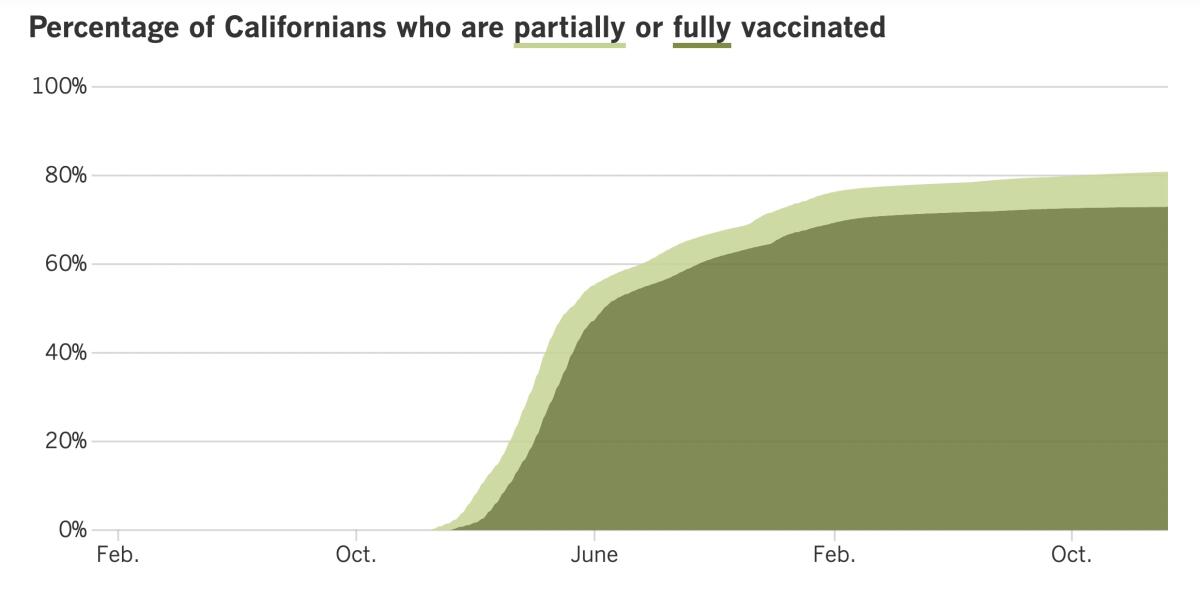
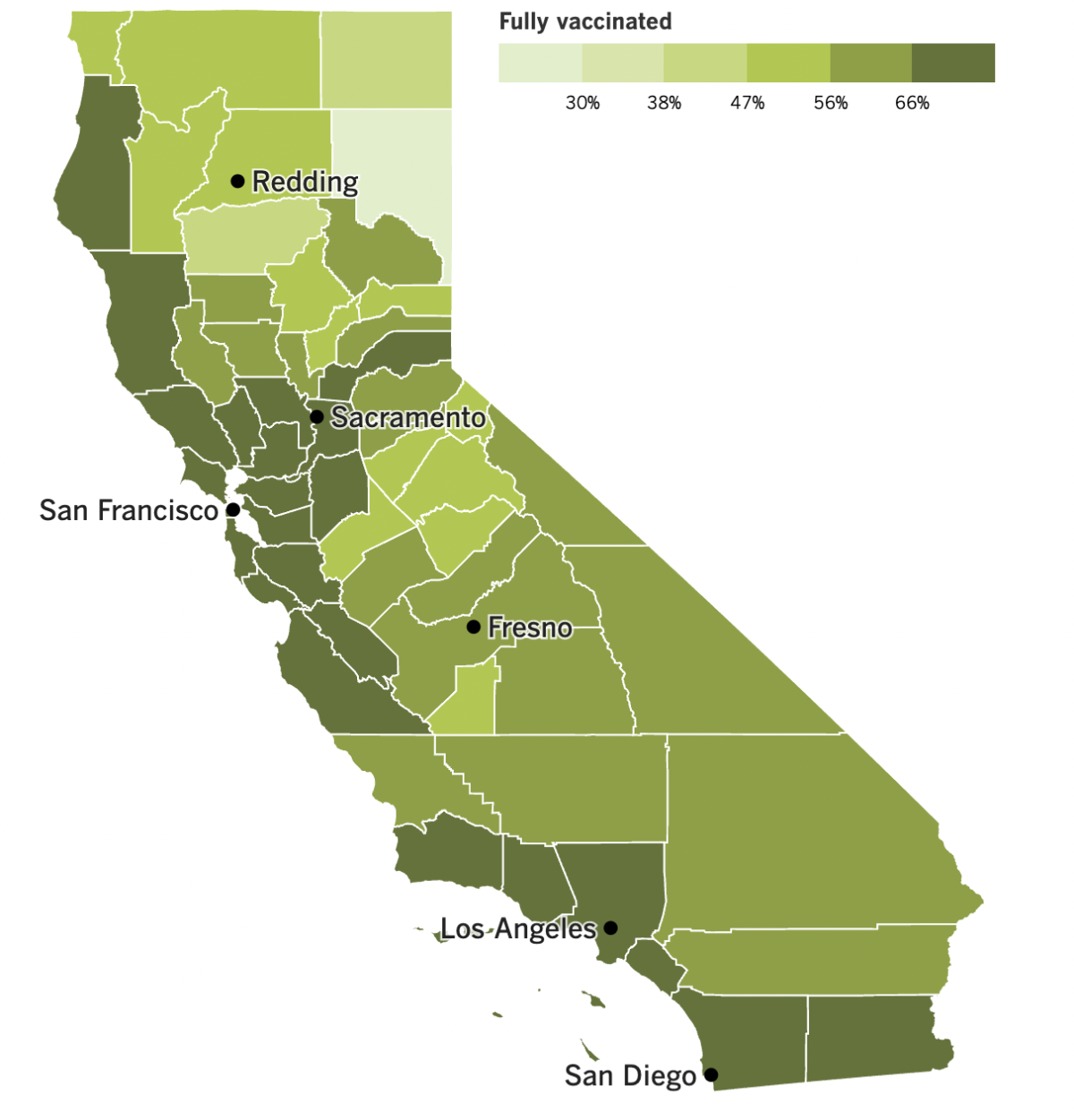
See the latest on California’s vaccination progress with our tracker.
Your support helps us deliver the news that matters most.
In other news ...
When we left off last time, Los Angeles was one of two California counties with the dubious honor of having a “high” COVID-19 community level, according to the CDC. (The other was Imperial County.) Despite the celebrations and social gatherings over the holidays, both counties have now made it into the “medium” level.
As of Thursday, the entire state falls into the “medium” or “low” categories. The counties with low COVID-19 community levels include Santa Barbara, San Luis Obispo, Santa Cruz, San Mateo and San Francisco, along with 10 counties in the state’s rural north and along the border with Nevada.
In L.A. County, things definitely got worse before they got better. A few days before Christmas, the weekly COVID-19 death toll rose to 150. That was higher than any single week during the summer surge fueled by the BA.5 Omicron subvariant. About 75% of those who died of COVID-19 in December were senior citizens age 70 and older, said county Public Health Director Barbara Ferrer.
There’s reason to hope things here will keep getting better. According to estimates from the state health department, the county’s effective coronavirus transmission rate is 0.88 as of Tuesday. That means each infected person is spreading the virus to fewer than one other person — in other words, transmission is decreasing.
Orange County’s rate is 0.93, Riverside County’s is 0.9, San Bernardino County’s is 0.99 and Ventura County’s is 0.97. San Diego County is headed in the wrong direction, with a transmission rate of 1.05. Statewide, the effective coronavirus transmission rate is 0.9.
L.A. County health officials have asked residents to help keep a good thing going by voluntarily wearing face masks in indoor public settings for at least 10 days after they return to school or work following their winter breaks. That way, if people became infected over the holidays but didn’t realize it, they’d be much less likely to spread the virus to others.
Indoor face coverings are required only in healthcare settings and nursing homes, per a statewide mask order. California health officials also require workers to wear masks on the job for 10 days if they’ve been in close contact with an infected person.
Another way to prevent coronavirus spread is to get a COVID-19 booster shot. The updated shots that target the Omicron variant as well as the original coronavirus strain are now available for California children as young as 6 months. (You can book a vaccine appointment for your child at MyTurn.ca.gov or by calling [833] 422-4255.)
The eligibility rules are a little different for infants, toddlers and preschoolers. Children ages 6 months to 5 years who got a full series of the Moderna vaccine can get Moderna’s bivalent booster if it’s been at least two months since their last shot. Children ages 6 months to 4 years who got a full series of the Pfizer-BioNTech vaccine aren’t eligible for a booster. But those who haven’t finished the three-dose series will get the updated formulation for their third shot.
Only 7% of Californians under 5 are fully vaccinated, state data show. And only 18.5% of Californians 5 and up have gotten a bivalent booster, according to the CDC. That puts the Golden State ahead of the nationwide figure of 15.4%, but not by much.
Perhaps some new research will make the booster shots more appealing. A preliminary study from Israel has found that people 65 and older who got Pfizer’s bivalent booster were 81% less likely to be hospitalized with COVID-19 than those who did not.
The findings are based on data collected between late September and mid-December from more than 600,000 people, and they represent the first real-world assessment of the retooled booster shots. The study was posted to a website established by the British medical journal Lancet to share early research results and has not yet been through the peer-review process.
Of the more than 537,000 participants who were not boosted, 73 died of COVID-19 during the 70-day study period. So did one of the more than 85,000 participants who did get a booster. Those figures suggest the shots helped reduce COVID-19 mortality, though the overall number of deaths was too small to make that claim with confidence, the researchers said.
Even so, the takeaway message is clear, said Dr. Oliver Brooks, the chief medical officer of Watts Healthcare in Los Angeles and a member of the CDC’s Advisory Committee on Immunization Practices.
“What we do know is, you’re better off vaccinated and boosted. Period,” Brooks said.
Your questions answered
Today’s question comes from readers who want to know: Did a COVID-19 vaccine cause Damar Hamlin to collapse on the football field?
In case you’re not a football an, Hamlin is the 24-year-old safety who plays for the Buffalo Bills and stunned millions of football fans last week when he inexplicably collapsed after tackling Cincinnati Bengals wide receiver Tee Higgins. Medical crews performed CPR and shocked his heart with a defibrillator before he was taken by ambulance to the University of Cincinnati Medical Center. He was discharged Monday and flown to Buffalo, where he will continue his recovery.
Although heart disease is the leading cause of death in the United States, a professional athlete in seemingly good health is hardly a typical victim. That has led some people on the internet to speculate that a COVID-19 vaccine must have been to blame.
Cardiologists say that’s almost certainly not the case.
Doctors may never know why Hamlin collapsed, but it may have been due to a condition called commotio cordis. It causes about 10 to 20 deaths per year in the United States, usually in young male athletes. If a hit is delivered to just the right place (the junction of the heart’s right atrium and right ventricle) at just the right time (a 20-millisecond window just before the heart pumps), the organ’s normal rhythm can be disrupted. If the arrhythmia isn’t corrected, the heart can’t carry out its normal functions.
Experts don’t know whether a tackle has the potential to set these events in motion — commotio cordis usually requires a small, fast-moving projectile such as a baseball or hockey puck. Even if it can, doctors suspect a preexisting condition would be necessary for a hit to have such devastating consequences.
Myocarditis could be one such condition. It’s an inflammation of the heart muscle that’s turned up as a rare side effect of the mRNA COVID-19 vaccines. (How rare? In September, the CDC said it had counted 131 such cases among more than 123 million people. None of them died.) The side effect was most often seen in adolescent boys and young men.
It’s likely that Hamlin is vaccinated, since the National Football League said about 95% of its players were vaccinated by the end of the last season. Only 17.7% of U.S. adults have received an Omicron-targeting booster shot, and we don’t know whether Hamlin was one of them.
Even if Hamlin did suffer commotio cordis and myocarditis did play a role — two big ifs — doctors say run-of-the-mill infections like the flu or the common cold are far more likely to cause myocarditis than a COVID-19 vaccine. In fact, COVID-19 itself causes more cases of myocarditis than the mRNA vaccines, according to the CDC.
When you put it all together, it’s really hard to see how the vaccines could be responsible, said Dr. Mark S. Link, a cardiologist at University of Texas Southwestern Medical Center who wrote a review article about commotio cordis for the journal Circulation: Arrhythmia and Electrophysiology.
“Is it absolutely ruled out?” Link said. “No, but it’s unlikely.”
We want to hear from you. Email us your coronavirus questions, and we’ll do our best to answer them. Wondering if your question’s already been answered? Check out our archive here.
The pandemic in pictures
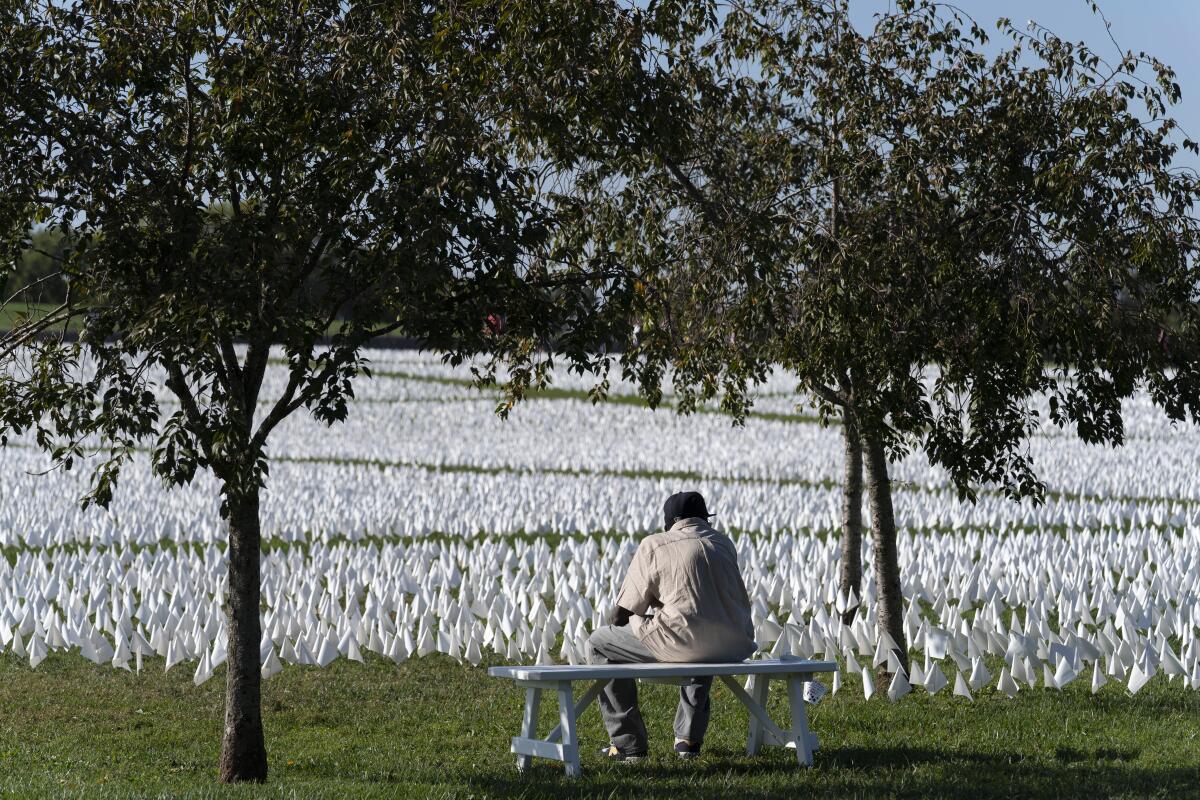
The white flags in the photo above are part of a temporary installation by artist Suzanne Brennan Firstenberg called “In America: Remember.” The flags were planted on the National Mall in Washington, D.C., for 17 days in 2021 to commemorate Americans who died of COVID-19.
The CDC recently completed its tally of U.S. deaths for 2021 and determined there were enough of them to cause the country’s average life expectancy at birth to decline for the second year in a row. An American baby born in 2021 could expect to live for about 76 years and 5 months. That average lifespan is 7.2 months shorter than it was for an American baby born in 2020 and the shortest it’s been in 25 years.
Let’s not forget that the average life expectancy at birth in 2020 was nearly 1 year and 10 months shorter than it was in 2019, before the coronavirus reached U.S. shores. It’s been nearly a century since American lifespans dropped so much in a two-year period.
COVID-19 was a major factor in the 2021 decline. A total of 416,893 Americans died of the pandemic disease in 2021, allowing it to repeat as the country’s third-leading cause of death (behind heart disease and cancer). The other big factor was drug overdose deaths, which numbered 106,699.
COVID-19 mortality rates for middle-aged and younger adults were higher in 2021 than 2020. The fact that the people who died of of the disease last year lost more years of potential life helps explain why the average life expectancy at birth fell by so much. When the CDC factored in the ages of people who died of drug overdoses, it found that from 2020 to 2021, mortality rates increased for every age group except for infants.
Resources
Need a vaccine? Here’s where to go: City of Los Angeles | Los Angeles County | Kern County | Orange County | Riverside County | San Bernardino County | San Diego County | San Luis Obispo County | Santa Barbara County | Ventura County
Practice social distancing using these tips, and wear a mask or two.
Watch for symptoms such as fever, cough, shortness of breath, chills, shaking with chills, muscle pain, headache, sore throat and loss of taste or smell. Here’s what to look for and when.
Need to get a test? Testing in California is free, and you can find a site online or call (833) 422-4255.
Americans are hurting in various ways. We have advice for helping kids cope, as well as resources for people experiencing domestic abuse.
We’ve answered hundreds of readers’ questions. Explore them in our archive here.
For our most up-to-date coverage, visit our homepage and our Health section, get our breaking news alerts, and follow us on Twitter and Instagram.




